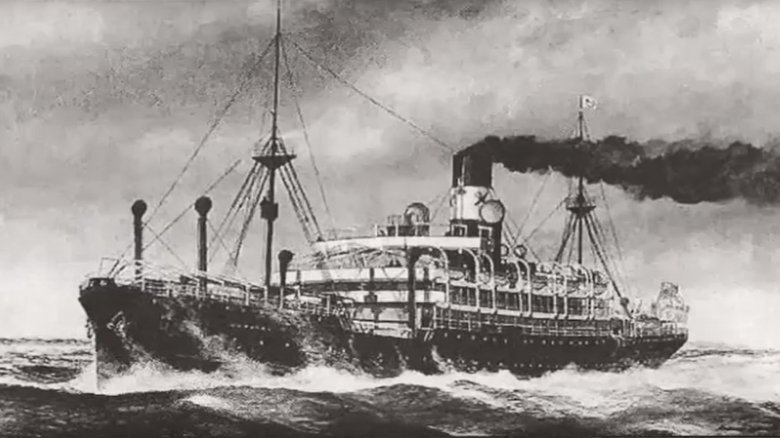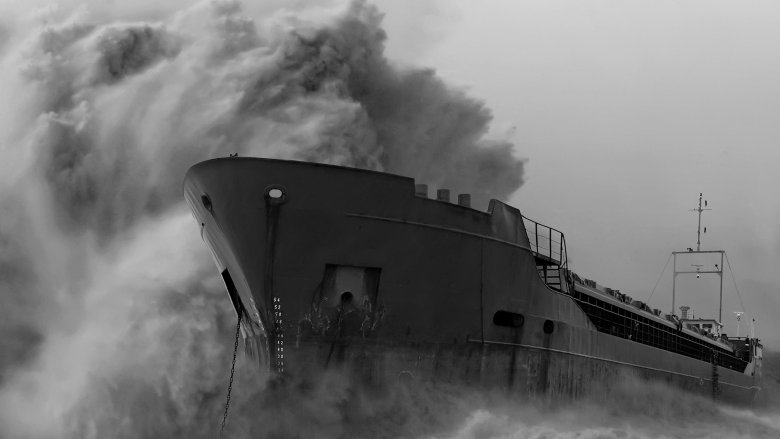Unexplained Mass Disappearances
It's a sad truth that people go missing all the time. And despite the desperate wishes of loved ones, the reasons for those disappearances are sometimes hard to find. But when large numbers of people go missing, you'd think the reasons should be quite obvious, and you'd be right...except when you aren't. Sometimes even entire civilizations can go missing without leaving behind a good explanation. Here are a few mass disappearances that are still mysteries.
SS Waratah
In July 1909, the SS Waratah was heading for Cape Town, South Africa, on its way back from Melbourne, Australia, making a scheduled stop in Durban on the way. It was carrying over 200 people comprised of both passengers and crew, but as it left port to complete its journey, one passenger elected to remain behind.
Engineer Claude Sawyer had made many journeys by sea, and he was so concerned by the behavior of this brand new ship that he disembarked in Durban and sent a message to his wife describing the ship as "top heavy." The Waratah left port at 8 a.m. on July 26, and headed into rough seas for its journey to Cape Town. At 6 a.m. the following day it overtook another ship, the Clan McIntyre, and exchanged signals, before the Waratah disappeared into the distance, never to be seen or heard from again.
According to the Master of a vessel called the Clan McIntyre, when the Waratah passed him, his ship was sailing into nine meter waves and a violent storm. Two ships later claimed to have seen bodies and debris in the water, however nothing was ever actually recovered.
An expedition sponsored by author Clive Cussler claimed to have found the ship in the 1980s. However, when the searchers eventually reached the wreck, they actually discovered a World War II transport vessel instead. The mystery of the SS Waratah's fate remains.
Aztalan Indians
Just outside the small town of Lake Mills in south central Wisconsin, on the banks of the Crawfish River, lie the remains of a Native American city called Aztalan. The Wisconsin settlers who discovered it in 1836 named it "Aztalan" due to a misplaced assumption that the Native Americans who lived there had a connection to the Aztecs.
The ancient city contained stepped pyramids, conical mounds, evidence of housing, fishing, and farming, and even a substantial defensive stockade wall containing up to 30 watchtowers. And according to local legend, they even built large stone pyramids in the bottom of what's now called Rock Lake in Lake Mills. But the valley was later flooded, meaning that evidence to prove this legend true is hard to come by.
At its peak, Aztalan would been occupied by around 500 people between 700 to a thousand years ago. But at some point after 1300 AD, the site was mysteriously abandoned, and no one really knows why.
According to an article published by Wisconsin Natural Resources Magazine, evidence points to a few different theories about their fate: a lack of resources, drought, and violence from other nearby Native American settlements.
Despite a very obvious intention of these early Wisconsinites to remain — nothing says "I'm staying!" like a large defensive wall — they're now nothing more than local history and legend.
Roman 9th Legion
The Ninth Legion was a Roman military formation of around 5,000 soldiers stationed in York in Northern England during Rome's occupation of Britain. This unit maintained control of the wild inhabitants of what would later become northern England and Scotland. In 108 AD, an inscription in the City of York places the legion in the city. However, 50 years later, when a new record of the legions was completed, no mention of the ninth appeared.
What could've happened to erase the existence of 5,000 soldiers? No one really knows.
According to a Roman writer, many Roman soldiers were killed in Britain at the beginning of the second century, necessitating several reinforcements. This included the arrival of a new Legion, the Sixth, in 122 AD, which took up residence in the now presumably empty York.
No records describe the Ninth Legion's fate. Some theories suggest the Legion was simply sent elsewhere, though there's little evidence to support this. Meanwhile, Emperor Hadrian visited the British Isles at the beginning of the second century. To take control of the Briton-on-Roman violence, he ordered the construction of a 73 mile long, 15 foot high, fortified wall across the island to keep the invaders out of Roman territory. And you don't go doing that unless you've got a good reason — like say losing an entire legion.
Hadrian's wall still stands today. However, there's still no sign of the ultimate fate of the Ninth legion — and there probably never will be.
Flying Tiger Line Flight 739
On March 16 1962, Flying Tiger Line Flight 739, a Lockheed Super Constellation airliner, was scheduled to transport 96 military personnel from the US to Vietnam. The aircraft was scheduled to make several stops for fuel on its way from California's Travis Air Force Base to Saigon, and everything was going by the book. But when it took off from Guam on its way to the last fuel stop in the Philippines, things went off script in a big way.
After the flight left Guam, it made its scheduled position reports on time, as well as an unexplained request to change altitude from 10,000 to 18,000 feet. However, when the plane was around two hours into the flight, the position reports ceased. Nothing was ever heard from flight 739 and its cargo of valuable military personnel again.
The only clue to its fate was the sighting of a midair explosion that appeared on the aircraft's approximate flight path. However, with no distress signals received, no mechanical issues reported, and no wreckage recovered from one of the largest search and rescue operations of the time, there's little evidence left to fill in the gaps.
The aircraft type was generally considered to be reliable, so mechanical explanations for the loss were quickly dismissed. The airline had little to offer in explanation beyond theories of hypothetical hijacking or sabotage. The only things we can really be sure of is that whatever happened was dramatic, and happened quick enough to prevent a mayday call. The truth seems as lost to us as the aircraft itself.
The population of Great Zimbabwe
The name "Zimbabwe" is an anglicized version of an African word that means "stone houses" and it comes from the name of a mysterious city: Great Zimbabwe. It should go without saying that the bigger a group of people is, and the more impressive, the harder it ought to be for them to disappear without anyone noticing. Which makes it a mystery of incredible proportions that a civilization of around 18,000 people — advanced enough to build sophisticated stone walls up to three stories high that gave its name to the nation of Zimbabwe — should be able to disappear without trace. But that's exactly what happened to the residents of Great Zimbabwe 400 years ago — and no one knows why.
The abandoned city as it exists now is constructed entirely of granite slabs, made using a technique called dry stone walling, that required no mortar to hold together. A multitude of artifacts have been found at the site that point to a history of trade, metal working in copper, bronze, and iron, and extensive religious beliefs. But despite all that information, all anyone knows about the disappearance are a few theories, which include changing trade routes, and depleting resources.
But since even the identity of the residents and builders of Great Zimbabwe is unknown, finding out why they abandoned such a significant city nearly half a millennium ago may be an impossible task.
SS Poet
The SS Poet was a former World War II troop transport that was mothballed for 20 years after the war, before being bought and converted to carry cargo. Considered "old but sturdy" in October 1980, the ship had an experienced crew of 34 men — including the captain who'd been at sea for 41 years — when it mysteriously disappeared.
On the morning of October 24, 1980, the SS Poet sailed from Philadelphia with a load of corn bound for Egypt, where it was due to arrive on November 9. As it passed Cape Henlopen later the same morning, the Poet sent its last message before heading out into the Atlantic, and into history.
The following day a storm blew up in the North Atlantic with 30 foot waves and 60 mph winds. But for a ship like the Poet that shouldn't have mattered. When the storm finally passed it left behind no trace of the Poet, no debris, and no distress signal was ever heard.
A popular explanation for the loss proposes an undiscovered hull leak that would have caused the ship to become unstable and founder in the bad weather. However with no evidence to back that up, fingers were soon pointed at the owner who had failed to report the ship missing for several days after losing contact, and at the coast guard who didn't begin a search for another four days after that. Well-built ships with experienced crews don't just vanish without cause, but that doesn't mean we'll ever know what it was.
Flight 19
By December 1945, World War II had been over for several months. In Florida, five US Navy torpedo bombers went out on a routine training exercise. The legend of the Bermuda Triangle had yet to be born. After successfully completing their practice bomb runs on shoals in the Bahamas, the aircraft of Flight 19 turned for home...or at least where they thought home was.
In fact, they were heading in the wrong direction and the weather was worsening. Flight 19 would never be seen again.
A few hours after Flight 19's disappearance, the largest search and rescue operation ever seen was launched to try and find the missing bombers. But despite hundreds of planes and ships scouring 200,000 square miles, no sign was ever found.
But Flight 19 wasn't the only victim of the Bermuda Triangle that day. Shortly after the emergency was declared, two Navy seaplanes were sent towards Flight 19's last known coordinates. One of them, with 13 men aboard, was also never heard from again. And those weren't the last disappearances to happen in that area. And until a better explanation turns up, it might as well get blamed on the Bermuda Triangle, right?
Moche civilization
The Moche civilization existed along the northern coast of Peru between 1 and 800 AD. According to archaeological discoveries, the Moche were sophisticated metal workers who had even mastered early forms of soldering and gilding. They were also sophisticated at human sacrifice, with an inclination to cut the throats of their victims and dismember them before burial. They were also pretty good at irrigation, which meant that they were able to feed a population that had climbed as high as 25,000...who all mysteriously vanished. When it came to surviving as a civilization, they could probably have used more practice.
A popular theory to explain the disappearance of the Moche was a super-El Nino that, between 560 and 650 AD, exposed the Moche to 30 years of rains, followed by 30 years of drought, devastating their agriculture and burying their monuments and homes in mud and sand, according to the BBC. This theory was doing well until new discoveries in the 1990s suggested that the Moche had actually survived the storms, and started building significant defensive structures that implied a period of violence. And since the only military hardware discovered at these locations was all Moche-made, it appears they may have been at war with themselves. Whether they were destroyed by weather, internal strife, or they just got sick of the view and moved to the mountains, we shall never know.
5th Battalion Norfolk Regiment
During World War I, the 5th Battalion of the Norfolk Regiment was formed at the King of England's Sandringham estate and recruited men from the King's staff. After training, the Norfolks joined the fighting in the Gallipoli campaign, which was intended to push Turkey out of the war. The Norfolks arrived in the theatre on August 10, 1915. Two days later, while still suffering from the long sea journey and before they could acclimatize to the conditions, they were sent into battle — their first, and last.
The attack was a mess. With inaccurate maps, poor information, and a seasoned and well-prepared enemy, there was really only one likely outcome, and the Norfolks marched stoically into it. During the assault, the Norfolks were separated from the main force. After pressing home their attack in the wrong place, pursued the enemy into a burning forest, and were never seen again.
When not a single soldier from the 5th Norfolks returned from the battle, it was assumed the whole unit had been captured. But the Turkish government had no record of the soldiers ever having been held. After the war, bodies were found that were identified as belonging to the missing unit, but later eyewitnesses came forward with bizarre reports of clouds enveloping the soldiers, which then flew away and left no trace that they had ever existed. You might think these stories would be quickly dismissed, but instead they just inspired a host of conspiracy theories and speculation that only served to confuse and undermine official efforts to discover the truth. And the true fate of the 5th Norfolks remains unresolved to this day.








